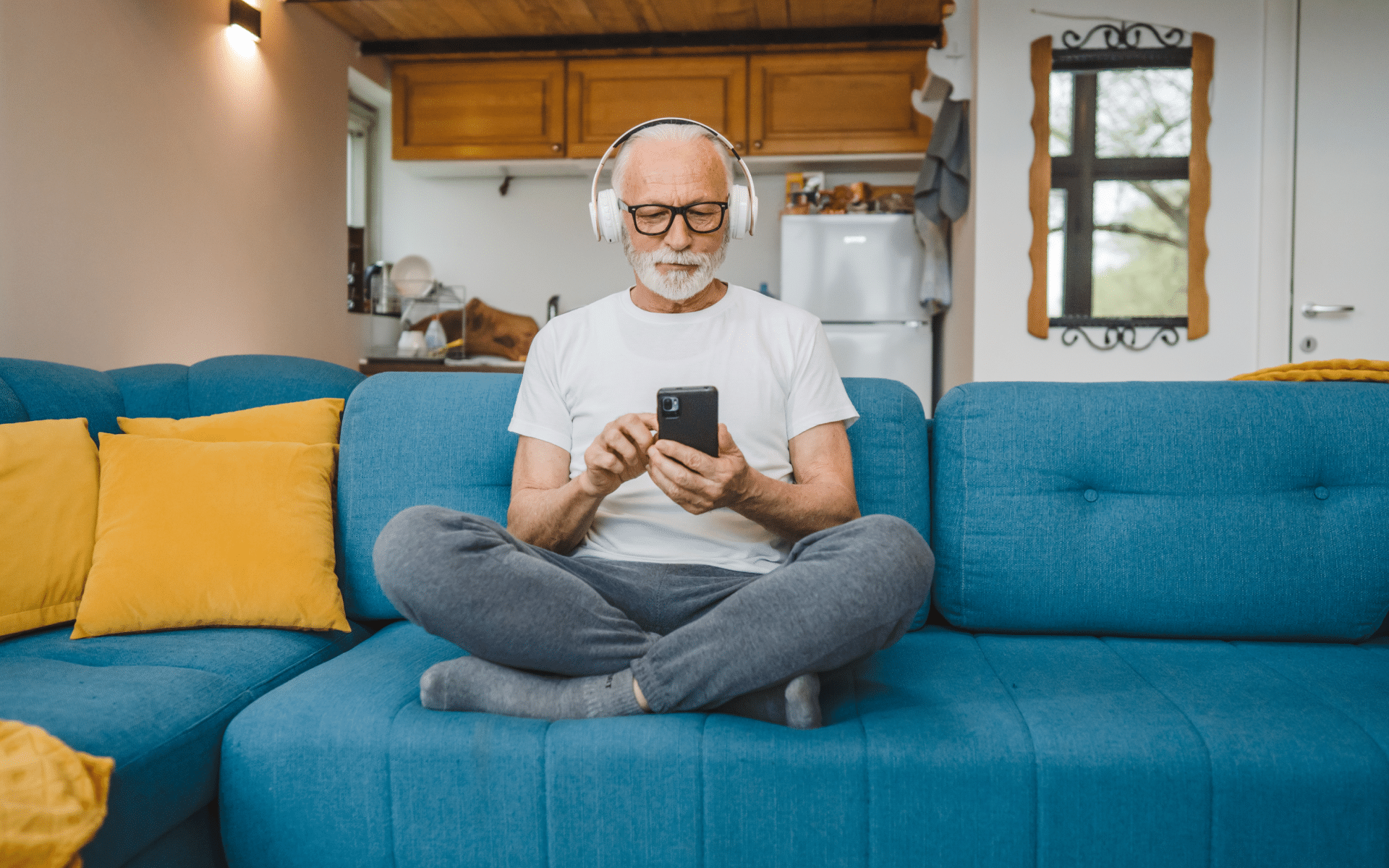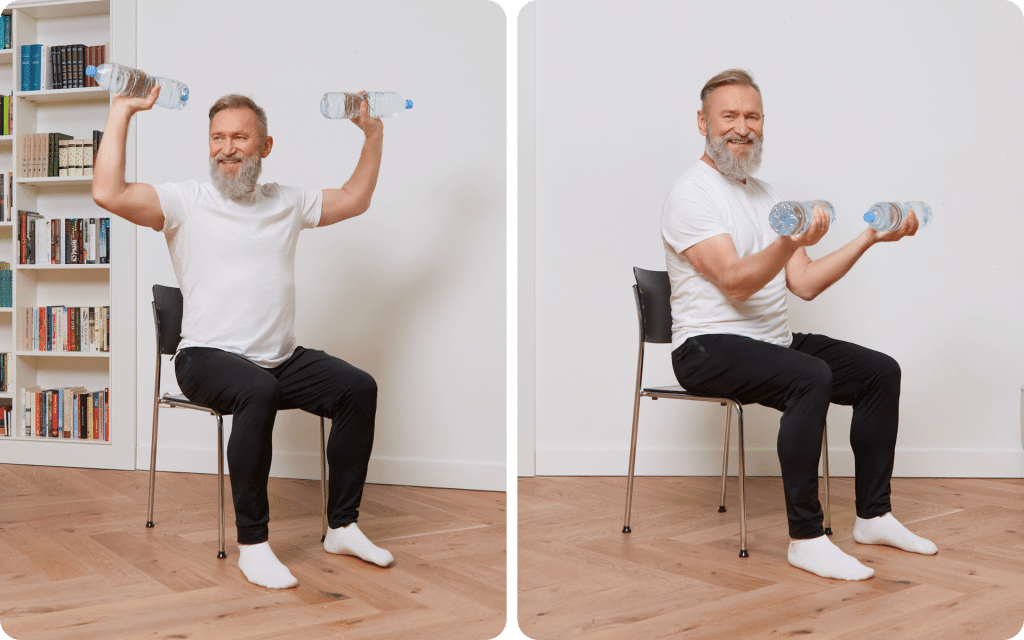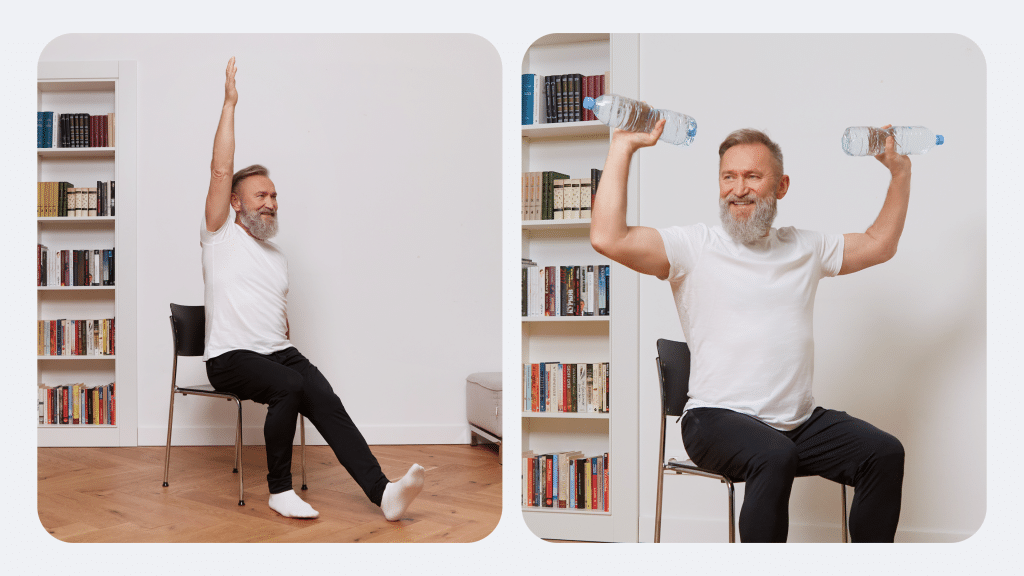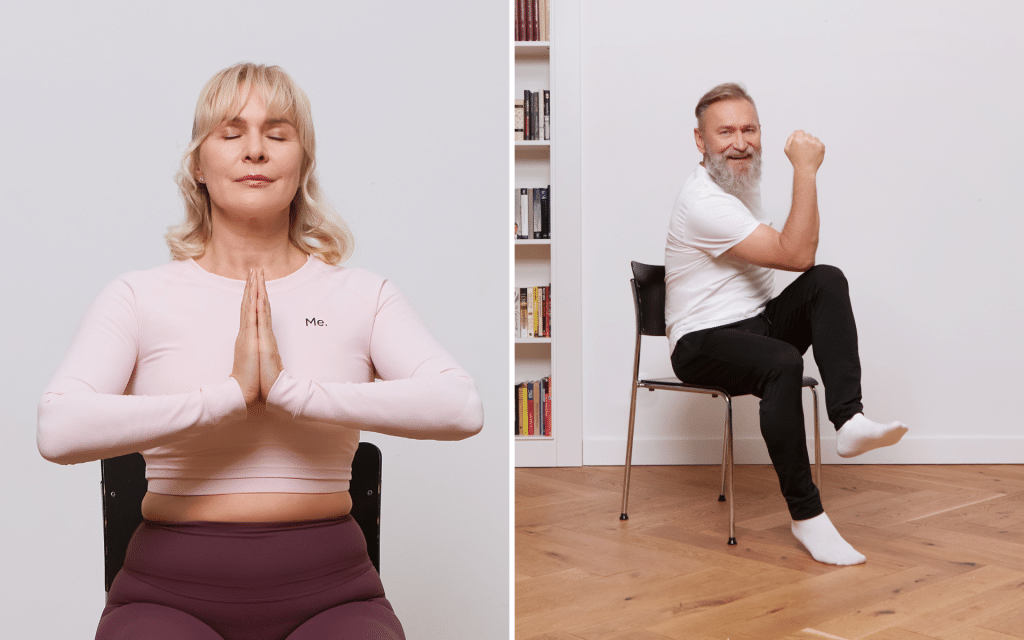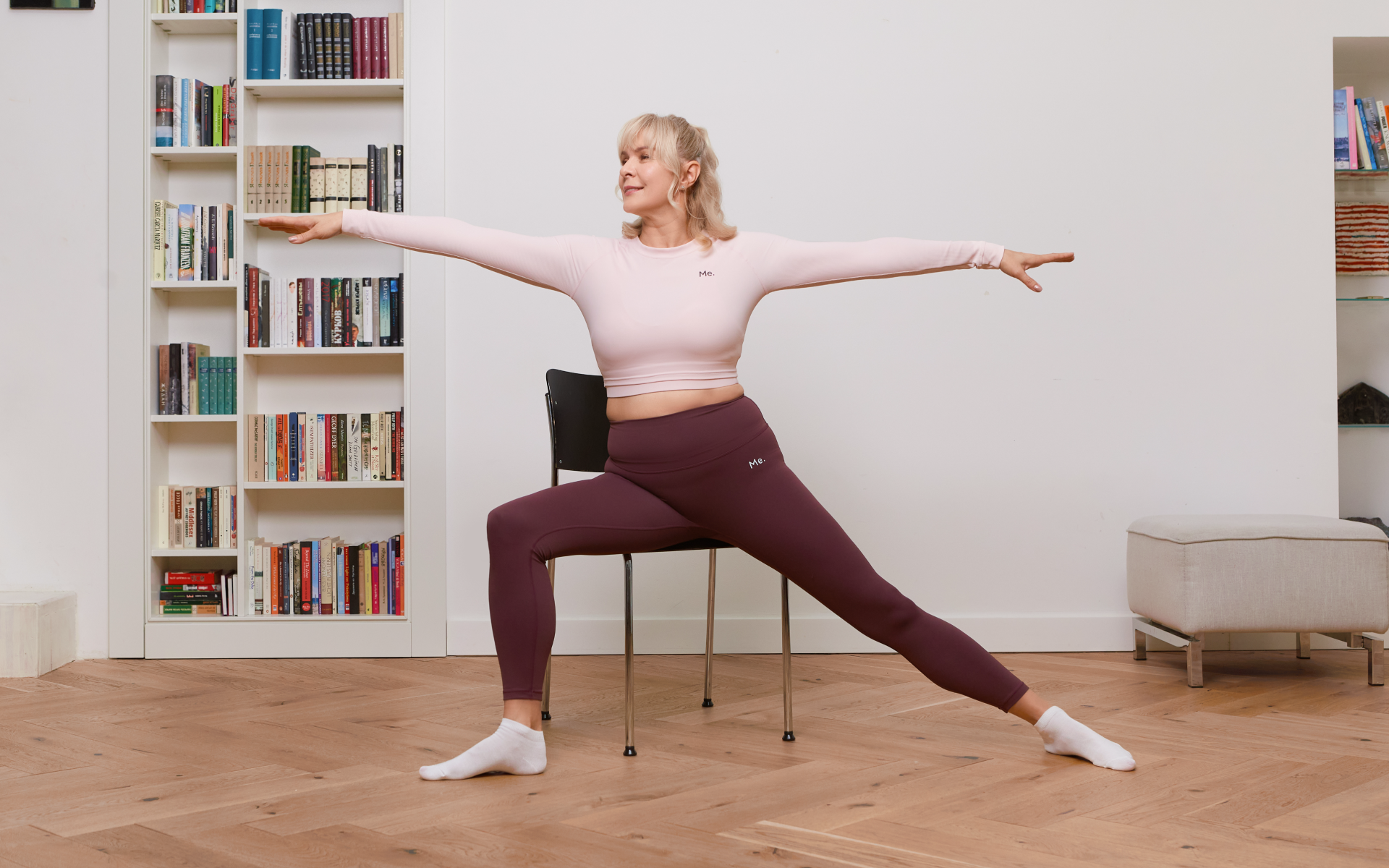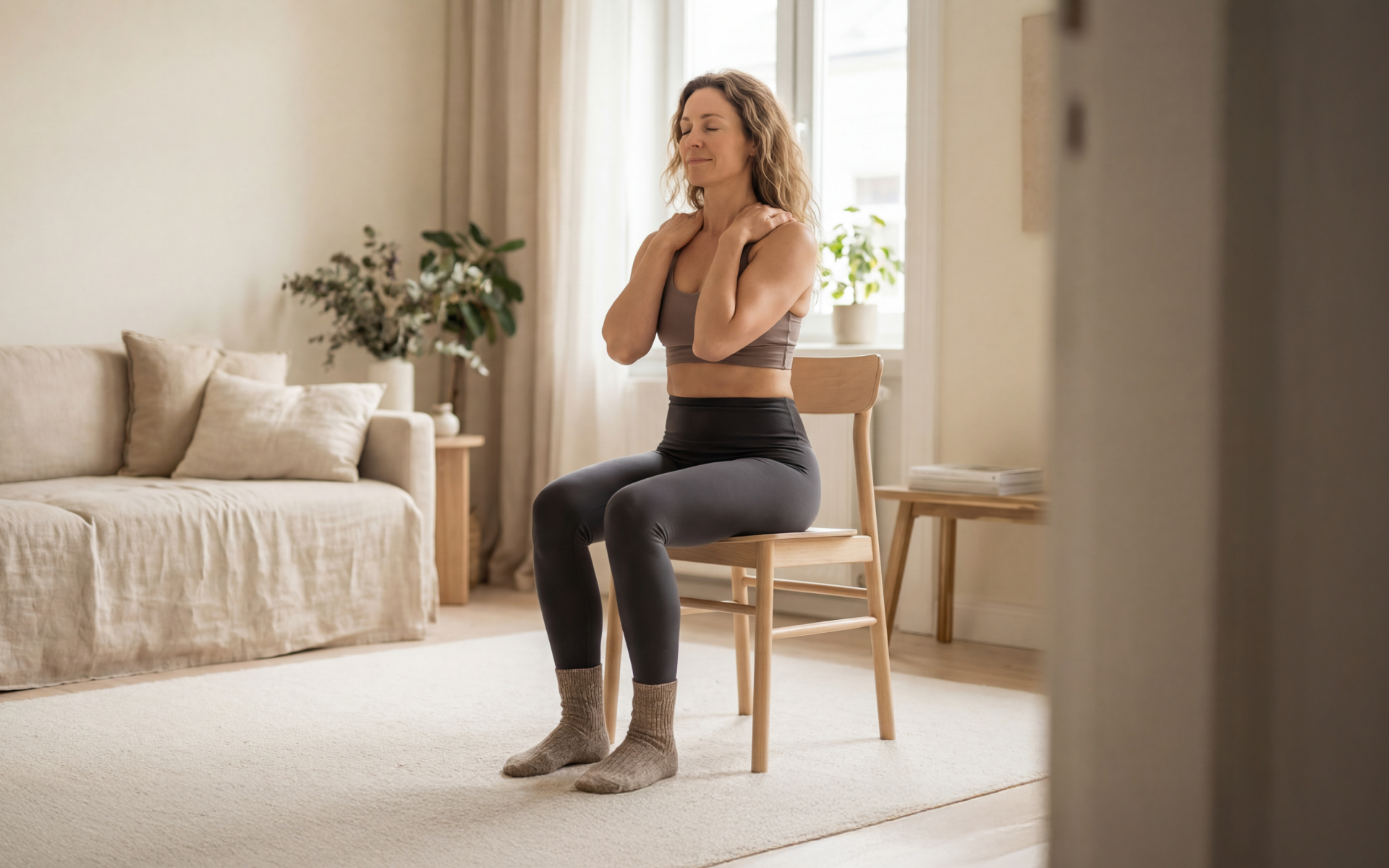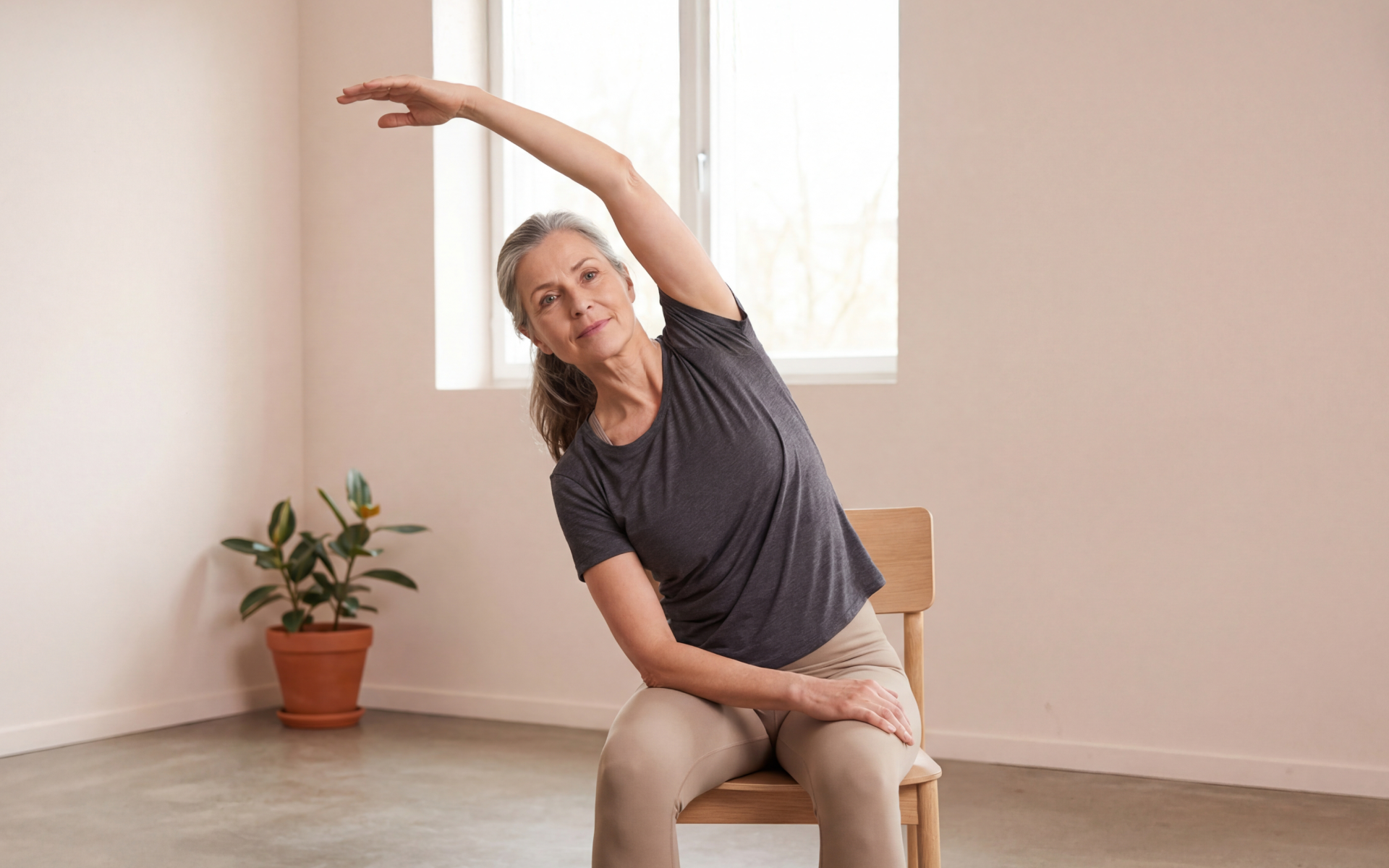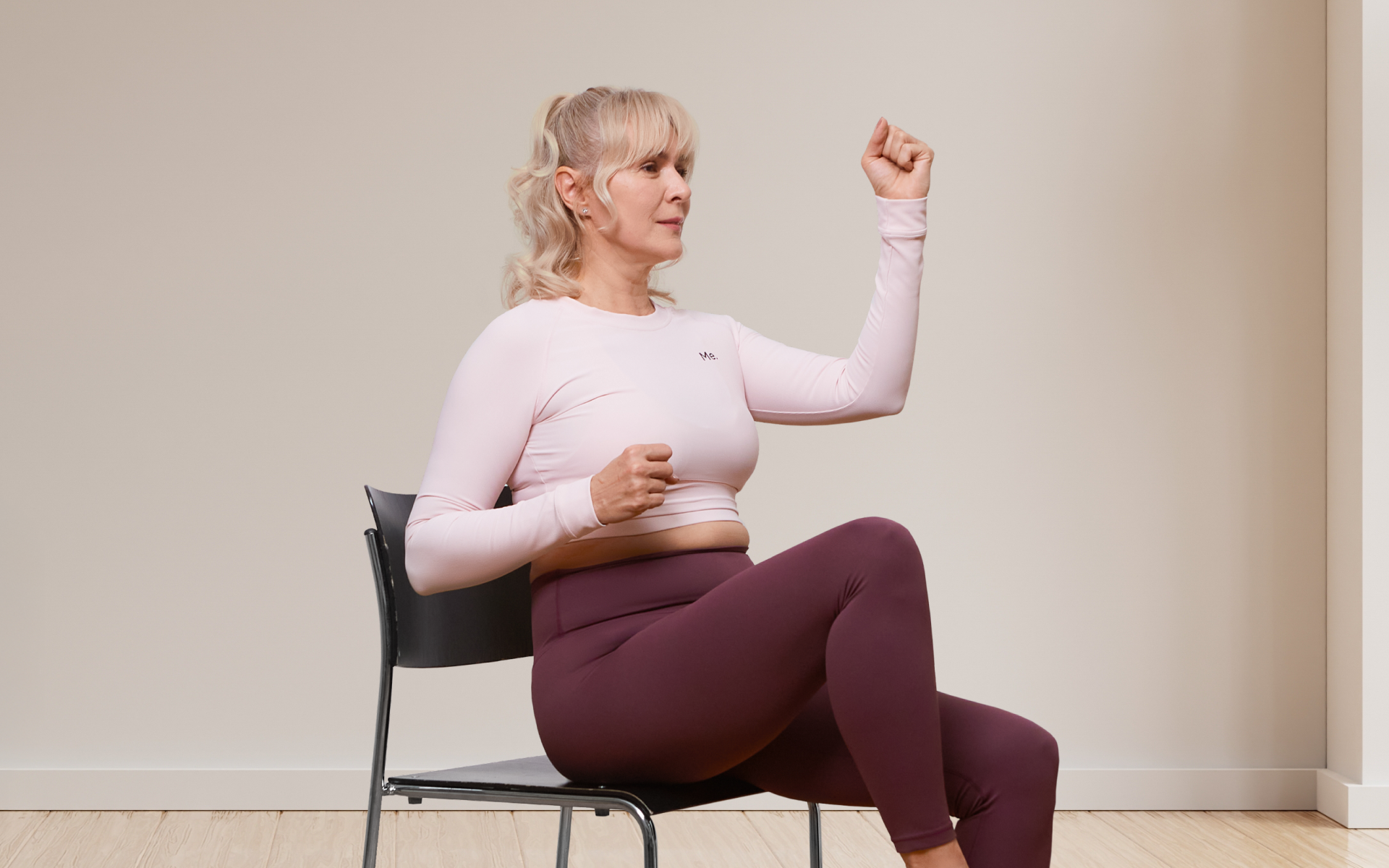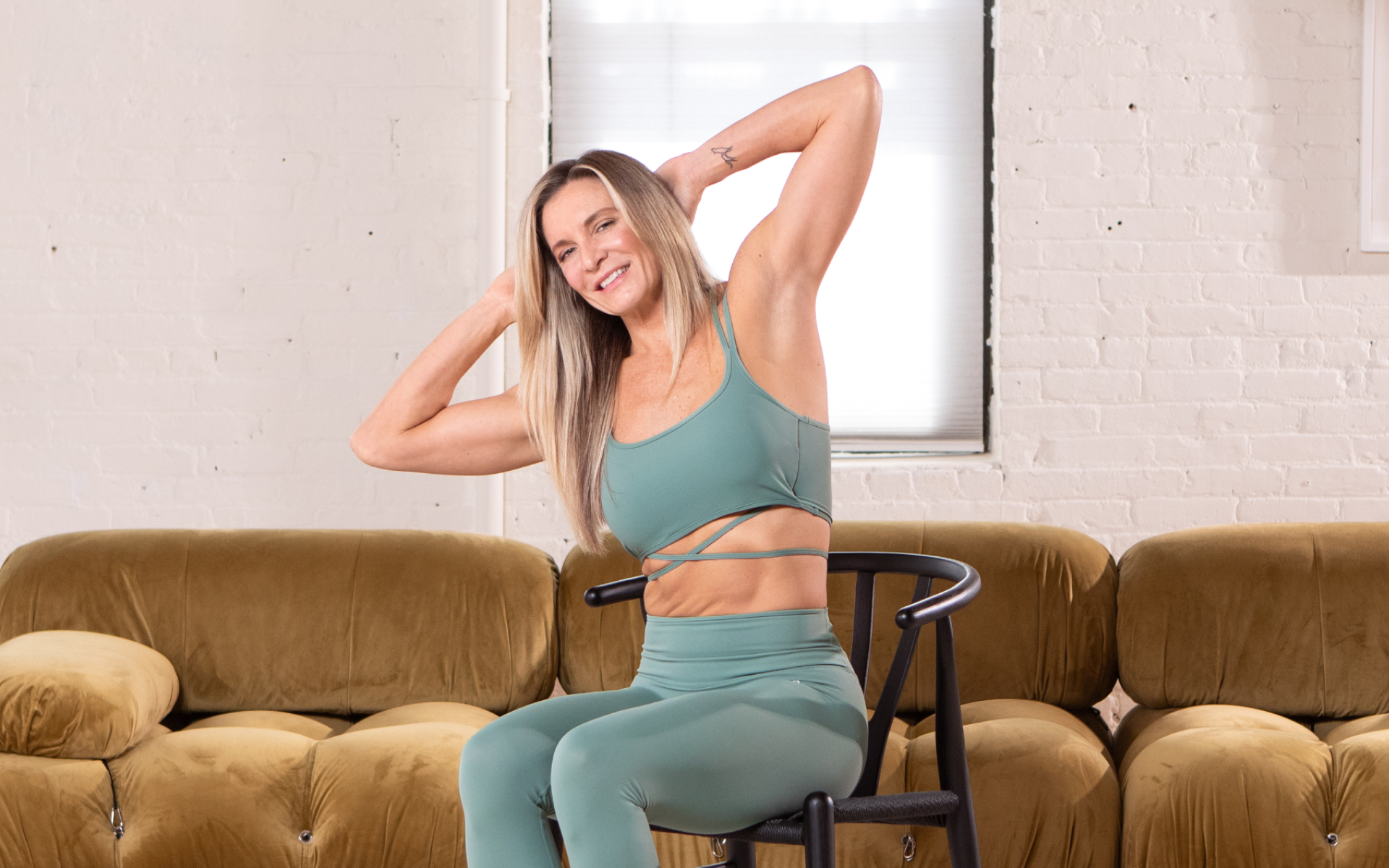It’s a common misconception that all men over 50 need to start slowing down and taking it easy. In fact, staying active and maintaining flexibility and strength is essential for overall health and wellness at any age (1).
Chair yoga is a great way for men over 50 to stay active without putting too much strain on their bodies. And it’s not just reserved for women – men can also benefit greatly from this gentle form of exercise (2).
To help you get started, here are 10 chair yoga exercises that are specifically designed for men over 50 to improve flexibility and strength.
We’ll also discuss the benefits of chair yoga and some tips for incorporating it into your daily routine.
Is Chair Yoga Good for Men in Their 50s?
Chair yoga offers numerous advantages for men in their 50s, focusing on enhancing flexibility, strength, and overall well-being in a gentle, low-impact manner (2).
- Improves Flexibility
As men age, maintaining flexibility becomes essential for preventing stiffness and improving range of motion (3). Just like conventional yoga, chair yoga incorporates a variety of stretching exercises that target different muscle groups, helping to keep the body limber and agile (4).
Regular practice can help alleviate the discomfort associated with tight muscles and joints, which makes daily activities easier and more comfortable.
- Enhances Strength
Chair yoga isn’t just about stretching, it also includes strength-building exercises that can help maintain and increase muscle mass. By using their own body weight and the support of a chair, men can engage in exercises that strengthen the core, legs, and upper body. This is particularly important for maintaining balance and stability, which can reduce the risk of falls and injuries (5).
- It’s a Low-Impact Exercise
One of the major benefits of chair yoga is the fact that it is a low-impact form of exercise, which makes it ideal for men with joint issues or those who are recovering from injuries. The gentle movements reduce the strain on the joints while still providing an effective workout. This makes chair yoga a sustainable and safe exercise option for men in their 50s.
- It Has Mental Health Benefits
Chair yoga also offers significant mental health benefits. The practice incorporates mindfulness and breathing exercises, which can help reduce stress and anxiety. The meditative aspect of yoga promotes mental clarity and focus, contributing to improved emotional well-being (6). Regular practice can lead to a calmer mind and a more resilient approach to life’s challenges.
Read more: Chair Yoga Routine for Seniors: 8 Exercises for a Full-Body Workout at Home
How Does Chair Yoga Change a Man’s Body?
Chair yoga can have a transformative effect on a man’s body, improving both physical and mental wellness. Some of the changes you may notice include:
- Improved Muscle Definition
Engaging in chair yoga involves performing a variety of poses and movements that utilize different muscle groups. This consistent engagement helps to define muscles, particularly in the core, legs, and upper body. Over time, men can experience a notable improvement in muscle mass and strength (7), contributing to a more toned and fit appearance.
- Increased Flexibility
One of the primary benefits of chair yoga is its ability to enhance flexibility. The exercises are designed to stretch and lengthen muscles, which can significantly improve the range of motion in the joints (4). Increased flexibility makes daily tasks easier and reduces the risk of injuries and muscle strains (8).
- Better Posture
Chair yoga emphasizes alignment and mindful movement, which can lead to better postural awareness. Many of the exercises focus on strengthening the muscles that support the spine, such as the core and back muscles. Improved postural awareness and control helps alleviate back pain and enhances overall physical appearance and confidence.
Whether you’re a workout beast or just a beginner making your first foray into the world of fitness and dieting – BetterMe has a lot to offer to both newbies and experts! Install the app and experience the versatility first-hand!
- Enhanced Balance
Balance tends to decline with age, which increases the risk of falls (9). Chair yoga includes exercises that challenge and improve balance, such as standing poses with the support of a chair. Enhanced balance contributes to physical safety and boosts overall coordination and stability.
- Positive Impact on Joint Health
Chair yoga can be particularly beneficial for men who are experiencing joint issues or arthritis. The gentle movements help lubricate the joints, reduce stiffness, and improve overall joint health (10). Regular practice can alleviate pain and increase mobility, which makes it easier to perform daily activities without discomfort.
- Potential for Weight Management
While chair yoga may not burn as many calories as high-intensity workouts, it still contributes to weight management. Chair yoga can be combined with strength training which boosts metabolism and helps build lean muscle mass (11). In addition, the mindfulness aspect of yoga can promote healthier eating habits and a more balanced lifestyle (12).
- Overall Improvement in Physical Fitness and Well-Being
Chair yoga offers a holistic approach to fitness, addressing both the body and mind. Regular practice of yoga can lead to improved cardiovascular health, better sleep quality, and a stronger immune system. The physical changes are complemented by mental benefits such as reduced stress, better focus, and a sense of overall well-being (13).
What Is the Best Chair Yoga Exercise for Men over 50?
While all chair yoga exercises offer a range of benefits, some are particularly beneficial for men over 50. Here are 10 of the best chair yoga exercises for men in their 50s:
1. Seated Cat-Cow Stretch
Description: Engages the muscles in the back, neck, and core.
Benefits: Enhances spinal mobility, reduces back and neck stiffness, and promotes relaxation.
How to Perform:
- Sit with your feet flat on the floor, hip-width apart.
- Place your hands on your knees.
- Inhale and arch your back, pushing your chest forward (cow pose).
- Tilt your pelvis forward and look up.
- Hold this position for a breath.
- Exhale and round your back, pulling your belly button toward your spine (cat pose).
- Tuck your chin toward your chest and tilt your pelvis backward.
- Hold this position for a breath.
- Repeat the sequence for 5-10 breaths, moving smoothly between cat and cow poses.
2. Seated Spinal Twist
Description: Engages the obliques, spinal erectors, and core muscles.
Benefits: Increases spinal flexibility, improves digestion, and releases tension in the back.
How to Perform:
- Sit with your feet flat on the floor.
- Place your right hand on the outside of your left thigh.
- Place your left hand on the back of the chair for support.
- Inhale to lengthen your spine.
- Exhale and twist to the left, starting from your lower back.
- Look over your left shoulder if comfortable.
- Hold the twist for 5 breaths, maintaining length in the spine.
- Slowly return to the center on an inhale.
- Switch sides and repeat the steps.
3. Chair Pigeon Pose
Description: Engages the hip flexors, glutes, and lower back muscles.
Benefits: Stretches the hips and glutes, alleviates lower back pain, and improves hip flexibility.
How to Perform:
- Sit with your feet flat on the floor.
- Lift your right foot and place your right ankle on your left thigh.
- Flex your right foot to protect your knee.
- Keep your back straight and sit tall.
- Gently press down on your right knee.
- Hold the stretch for 5-10 breaths.
- If you want to deepen the stretch, lean forward from your hips.
- Return to an upright position on an inhale.
- Switch sides and repeat the steps.
4. Seated Side Stretch
Description: Engages the obliques, intercostal muscles, and the latissimus dorsi.
Benefits: Increases flexibility in the sides of the body, improves spinal mobility, and relieves tension in the shoulders and neck.
How to Perform:
- Sit with your feet flat on the floor.
- Raise your right arm overhead.
- Place your left hand on the chair seat.
- Inhale to lengthen your spine.
- Exhale and lean to the left, stretching your right side.
- Keep both sit bones anchored on the chair.
- Look up towards your right hand if comfortable.
- Hold the stretch for 5 breaths.
- Return to the center on an inhale.
- Switch sides and repeat the steps.
5. Seated Leg Lifts
Description: Engages the quadriceps, hip flexors, and core muscles.
Benefits: Strengthens the quadriceps and stretches the hamstrings.
How to Perform:
- Sit with your feet flat on the floor.
- Place your hands on the sides of the chair for support.
- Lift your right leg to straighten it out in front of you.
- Hold the leg up for a few seconds.
- Lower the leg back down slowly.
- Repeat 10 times with the right leg.
- Switch to the left leg and repeat the steps.
- To increase difficulty, try lifting both legs simultaneously.
- Focus on keeping your back straight and core engaged.
- Rest between sets if needed.
6. Seated Warrior Pose
Description: Engages the quadriceps, hamstrings, glutes, and core muscles.
Benefits: Strengthens legs and core, improves seated balance and stability, and enhances overall body awareness.
How to Perform:
- Sit sideways on the chair with your left leg bent at a 90-degree angle.
- Extend your right leg behind you, keeping it straight.
- Ensure your left knee is directly above your left ankle.
- Raise your arms to shoulder height.
- Turn your torso to face forward.
- Hold the pose for 5-10 breaths.
- Maintain length in your spine and openness in your chest.
- Lower your arms and switch sides.
- Repeat the steps on the other side.
- Focus on deep, steady breaths throughout the pose.
BetterMe: Health Coaching app helps you achieve your body goals with ease and efficiency by helping to choose proper meal plans and effective workouts. Start using our app and you will see good results in a short time.
7. Seated Shoulder Rolls
Description: Engages the trapezius, deltoids, and neck muscles.
Benefits: Relieves shoulder and neck tension, improves shoulder mobility, and promotes relaxation.
How to Perform:
- Sit with your feet flat on the floor.
- Inhale and lift your shoulders toward your ears.
- Exhale and roll your shoulders back and down.
- Continue the rolling motion for 10 times.
- Make the movements slow and controlled.
- Reverse the direction and roll your shoulders forward 10 times.
- Focus on releasing any tension with each exhale.
- Keep your spine straight and core engaged.
- Incorporate deep breathing for added relaxation.
- Finish with a few shoulder shrugs.
8. Seated Ankle Circles
Description: Engages the muscles around the ankles, including the calf muscles.
Benefits: Enhances ankle flexibility, promotes blood circulation, and reduces stiffness in the feet.
How to Perform:
- Sit with your feet flat on the floor.
- Lift your right foot off the ground.
- Rotate your ankle in circular motions 10 times.
- Make the circles as wide as possible.
- Reverse the direction and rotate 10 times.
- Lower the right foot and lift the left foot.
- Repeat the ankle rotations on the left foot.
- Focus on smooth and controlled movements.
- Engage your core to maintain balance.
- Finish by flexing and pointing your toes a few times.
9. Seated Chest Opener
Description: Engages the pectoral muscles, deltoids, and trapezius.
Benefits: Stretches the chest and shoulders, improves posture, and opens up the chest for better breathing.
How to Perform:
- Sit with your feet flat on the floor.
- Clasp your hands behind your back.
- Straighten your arms and squeeze your shoulder blades together.
- Gently lift your hands away from your back.
- Inhale deeply to expand your chest.
- Hold the position for 5-10 breaths.
- Release the clasp and return to a neutral position.
- Repeat the stretch if needed.
- Focus on keeping your spine long and shoulders relaxed.
- Incorporate deep breathing for added benefits.
10. Seated Forward Bend
Description: Engages the hamstrings, lower back, and hip muscles.
Benefits: Improves flexibility of the lower back, hamstrings, and hips, and promotes relaxation.
How to Perform:
- Sit with your feet flat on the floor.
- Place your hands on your thighs.
- Inhale and lengthen your spine.
- Exhale and hinge at your hips.
- Reach your hands towards your feet, keeping your back straight.
- If you can’t reach your feet, rest your hands on your shins or thighs.
- Hold the pose for 5-10 breaths.
- Allow your body to relax with each exhale.
- Engage your core and slowly roll back up to a seated position on an inhale.
- Repeat as needed, focusing on deep, steady breaths.
Why Do Men Struggle with Yoga?
Men may struggle with yoga for a variety of reasons, including societal expectations, flexibility limitations, and lack of exposure.
Historically, yoga has been seen as a practice mainly for women, and men may feel uncomfortable or out of place in a predominantly female environment. This can create a mental barrier that prevents them from trying yoga (14).
Men are often expected to be strong and muscular, which leads to a focus on weightlifting and other forms of exercise rather than stretching and mobility. As a result, many men may have limited flexibility, making certain poses in yoga more challenging for them.
In addition, many men have not been exposed to yoga in their formative years as girls have through activities such as dance or gymnastics. This lack of experience can make it more difficult for them to pick up the fundamentals of yoga.
However, men can benefit tremendously from incorporating yoga into their fitness routines. It can help improve flexibility, strength, and balance while also reducing stress and promoting relaxation (13).
By breaking down societal expectations and giving it a try, men can discover the many benefits of yoga for their physical and mental well-being.
Read more: Chair Yoga and Weightlifting
Is it Too Late to Start Chair Yoga at 50?
It’s never too late to start practicing chair yoga, regardless of your age. In fact, starting at 50 or older can bring even more benefits.
As we age, our bodies naturally lose muscle mass and mobility. This can lead to stiffness, fragility, and increased risk of falls (15).
Chair yoga can help combat these effects by gently stretching and strengthening the muscles in a safe and supported way that results in improved physical function (2).
In addition, chair yoga focuses on deep breathing and relaxation techniques, which can help reduce stress and improve overall well-being. It’s also a low-impact form of exercise that’s accessible for all fitness levels.
No matter your age, incorporating chair yoga into your daily routine can have numerous physical and mental health benefits.
Does Yoga Help Slow Aging?
Yoga has been shown to have numerous anti-aging benefits for the body and mind. Some studies have suggested that practicing yoga regularly can slow down the aging process and even reverse some of its effects (17).
One key benefit of yoga is its ability to reduce stress and promote relaxation (18). Stress hormones, such as cortisol, can speed up the aging process by damaging cells in the body (19). By reducing stress levels, yoga can help slow this damage and keep cells healthier for longer.
Yoga also helps improve flexibility, balance, and muscle strength (4), all of which tend to decline with age. By maintaining or improving these aspects of physical health, individuals may experience a slower decline in their overall physical capabilities.
Regular yoga practice has also been linked to improved mental clarity and cognitive function, which can help combat age-related memory decline (20).
Three benefits of practicing yoga for individuals over 50 years old include improved flexibility, stress reduction, and increased muscle strength (17). Seniors should do yoga every day if they’re physically able and it fits into their lifestyle. Provided they have proper instruction and listen to their body’s limitations, a daily yoga practice can offer numerous benefits for seniors. However, it’s important to also incorporate rest days and listen to the body’s needs for recovery. Yoga is definitely worth it for men. It offers numerous physical and mental benefits, including improved flexibility, strength, balance, and stress reduction (13). It can also serve as a low-impact form of exercise that is accessible for all fitness levels. With proper instruction and an open mind, men can reap the many rewards of incorporating yoga into their fitness routine. 20 minutes of yoga a day can make a significant difference to your physical and mental well-being. Regular practice has been linked to increased flexibility, strength, and balance, in addition to stress reduction and improved cognitive function. While longer sessions may provide more benefits, even short daily practices can have positive effects on the body and mind over time. After 3 months of consistent yoga practice, individuals may notice improvements in their flexibility, strength, and balance. They may also experience reduced stress levels and improved mental clarity (13). These changes can vary depending on each person’s starting point and the frequency/intensity of their yoga practice.Frequently Asked Questions
What are 3 benefits of practicing yoga when you’re over 50 years old?
Should seniors do yoga every day?
Is yoga worth it for men?
Will 20 minutes of yoga a day make a difference?
What happens after 3 months of yoga?
The Bottom Line
Chair yoga is an excellent way for people of all ages, genders, and abilities to incorporate the benefits of yoga into their daily lives. It’s a gentle and accessible form of exercise that can improve physical strength and flexibility while promoting relaxation and reducing stress. So, whether you’re a man who is struggling to try yoga or someone in their 50s who is looking for a low-impact exercise option, give chair yoga a try and experience the positive effects it can have on your overall well-being.
DISCLAIMER:
This article is intended for general informational purposes only and does not serve to address individual circumstances. It is not a substitute for professional advice or help and should not be relied on for making any kind of decision-making. Any action taken as a direct or indirect result of the information in this article is entirely at your own risk and is your sole responsibility.
BetterMe, its content staff, and its medical advisors accept no responsibility for inaccuracies, errors, misstatements, inconsistencies, or omissions and specifically disclaim any liability, loss or risk, personal, professional or otherwise, which may be incurred as a consequence, directly or indirectly, of the use and/or application of any content.
You should always seek the advice of your physician or other qualified health provider with any questions you may have regarding a medical condition or your specific situation. Never disregard professional medical advice or delay seeking it because of BetterMe content. If you suspect or think you may have a medical emergency, call your doctor.
SOURCES:
- Examining Physical Wellness as the Fundamental Element for Achieving Holistic Well-Being in Older Persons: Review of Literature and Practical Application in Daily Life (2023, ncbi.nlm.nih.gov)
- The Effectiveness of Chair Yoga in Older Adults: A Literature Review (2023, researchgate.net)
- Ageing – muscles bones and joints (2015, betterhealth.vic.gov.au) 3
- Effects of yoga on flexibility and balance: a quasi-experimental study (2017, researchgate.net)
- Effect of a 12-week yoga intervention on fear of falling and balance in older adults: a pilot study (2010, pubmed.ncbi.nlm.nih.gov)
- Fifteen Minutes of Chair-Based Yoga Postures or Guided Meditation Performed in the Office Can Elicit a Relaxation Response (2012, ncbi.nlm.nih.gov)
- Yoga Exercise Intervention Improves Balance Control and Prevents Falls in Seniors Aged 65+ (2022, ncbi.nlm.nih.gov)
- The importance of stretching (2024, health.harvard.edu)
- Falls and Fall Prevention in Older Adults (2023, ncbi.nlm.nih.gov)
- Yoga Benefits for Arthritis (n.d., arthritis.org)
- How can strength training build healthier bodies as we age? (2022, nia.nih.gov)
- Yoga’s potential for promoting healthy eating and physical activity behaviors among young adults: a mixed-methods study (2018, ncbi.nlm.nih.gov)
- Exploring the therapeutic effects of yoga and its ability to increase quality of life (2011, ncbi.nlm.nih.gov)
- Yoga not a (physical) culture for men? Understanding the barriers for yoga participation among men (2021, sciencedirect.com)
- Muscle and Bone Mass Loss in the Elderly Population: Advances in diagnosis and treatment (2018, ncbi.nlm.nih.gov)
- Muscle and Bone Mass Loss in the Elderly Population: Advances in diagnosis and treatment (2018, ncbi.nlm.nih.gov)
- Yoga for Healthy Aging: Science or Hype? (2021, ncbi.nlm.nih.gov)
- Reduce stress and the risk of burnout by using yoga techniques. Pilot study (2024, frontiersin.org)
- Stress-Induced Biological Aging: A Review and Guide for Research Priorities (2022, ncbi.nlm.nih.gov)
- Yoga Impacts Cognitive Health: Neurophysiological Changes and Stress-regulation Mechanisms (2022, ncbi.nlm.nih.gov)
